Shola forests are tropical Montane forest patches found within the valleys separated by grasslands only at elevations above 1600 meters. It is found exclusively in South India, especially within the Southern Western Ghats. The shola forests are patches of forests that occur within the valleys where there’s less fog and mist to damage the plants. Grasslands cover the other parts of the mountains. The trees never grow on the open, exposed mountain tops. This is a really unique landscape formation that is found only in the southern Western Ghats. The word “Shola” comes from the Tamil word சோலை (cÕlai) which means “grove“. This origin of these forests, however, is still under debate. Some suggest that these resulted from the indigenous folks that lived here controlling and maintaining the growth of grasslands by constantly burning them. But samples from the soil of the mountains proved that the forests existed way before humans evolved. In 1984, deep bore samples were taken from the mountains of the shola forests and were analyzed. The result was that they contained the identical material that the soil was made today (which was a result of dead grass) and hence it remained grassland thousands of years prior to the humans!
Occurrence:
The Shola forests are generally said to be found in altitudes above 2000 meters of sea-level. Although they are found from altitudes higher than 1600 meters. Shola forests are native only to the Southern Western Ghats. They are found only in the high altitude mountains of the states Karnataka, Kerala, and Tamilnadu. Nowhere else in the world exist such a kind of forest. There are several hypotheses that explain such a unique occurrence of grasslands and forest mosaics. Some suggest the grasslands were mad-made and controlled by fire and grazing. This theory also suggests that the periodic fires ensured that no trees grew in the mountain tops restricting them only to the depressions between the mountains.
Another theory suggests that the reason why the forests could not survive the mountain tops was due to the excessive frost that exists there. The frost does not allow seeds of the Shola species to germinate or the seedlings cannot survive the extreme frost. The leaves of the plants get damaged and they cannot sustain there. Whereas, in the depressions between the hills, the damage caused by the frost is a lot less compared to the open hill-tops. The Shola trees can grow and sustain well there.
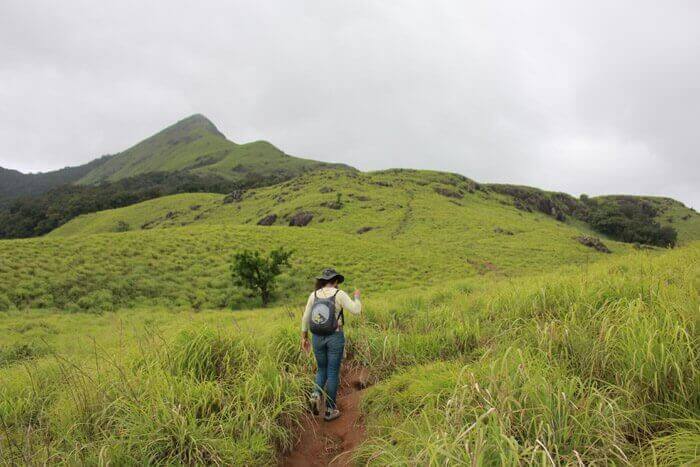
Shola forests on Chembra peak, Wayanad, Kerala, India.
Flora:
The grasslands consist of different species of grass and mostly the following species are seen widely,
- Chrysopogon zeylanicus
- Cymbopogon flexuosus
- Arundinella ciliata
- Arundinella mesophylla
- Arundinella tuberculata
- Themeda tremula
- Sehima nervosum.
Due to high isolation and unique climatic conditions, the Shola forests are characterized by high endemism. The species of plants and animals found here are native to this region (this climatic region to be more specific) and such species cannot be found anywhere else in the world.
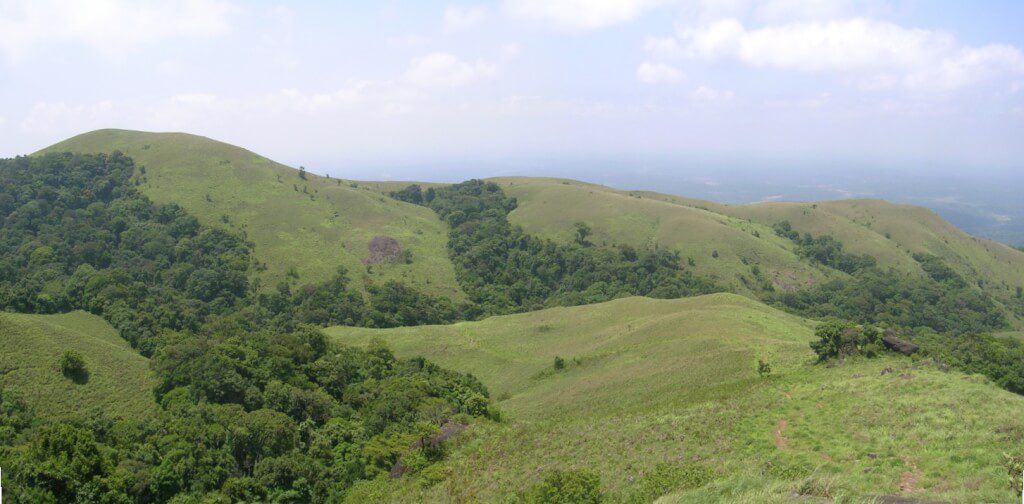
Shola forests of Brahmagiri Hills, Karnataka, India
Fauna:
These forests are rich in endemic species of animals where some species of animals have adapted to this unique landscape and are found nowhere else in this world. Several amphibian species are found only here and a few mammal species and primates are native to the southern Western Ghats. Some of them are,
Large animals like Tiger, Elephants, Leopard, and Gaurs are also found to inhabit the grassland-shola complex.
Vulnerability and Current status:
These forests are extremely vulnerable to several threats. There are several reasons for the diminishing shola-grassland complex. They are,
- The Shola tree species have one of the lowest regeneration rates. They do not get established very soon. They are generally slow-growing and need more time to establish themselves and are very sensitive to climatic conditions which make them very vulnerable. Moreover, most Shola trees produce drupaceous fruits which are difficult to produce more seeds and there is less way to disperse them successfully.
- These forests and grasslands are being cleared for agriculture. These forests are relatively easy to clear as they constitute mainly of grasslands and trees are generally stunted with no timber value.
- Construction of hill stations is another major threat to these forests. These forests usually exist in higher elevations, these places, unfortunately, have a suitable climate to be made as Hill stations and tourist spots. Several hill stations in Southern India were established after the destruction of thousands of acres of shola forests. Some of them are, Ooty, Kodaikanal, Munnar, Coorg, Valparai, Kotagiri, Kodanad, Megamalai.
- Mining activities are increasing in the Western Ghats for various reasons like Bauxite, Gypsum, Granites, and various other rocks and minerals. This leads to habitat destruction of the flora and fauna of the Western Ghats.
- hydroelectric projects and dams are a great threat as it submerges thousands of acres of forests. The Government even does such folly and the dams are usually given up after a certain period of time as the reservoirs become of no use after prolonged silt deposition. Forests cannot get established even after the dam becomes inoperational as the silt is not nutritious enough for the forest species and the area remains a barren land.
- South Indian tea is famous all over the world. This may sound like a great thing. But we are paying a huge loss for this fame and money. Millions of acres of hill-tops and slopes which were once covered in grasslands and shola forests are now barren tea plantations. They will just be green deserts in the nature conservationist’s eyes.
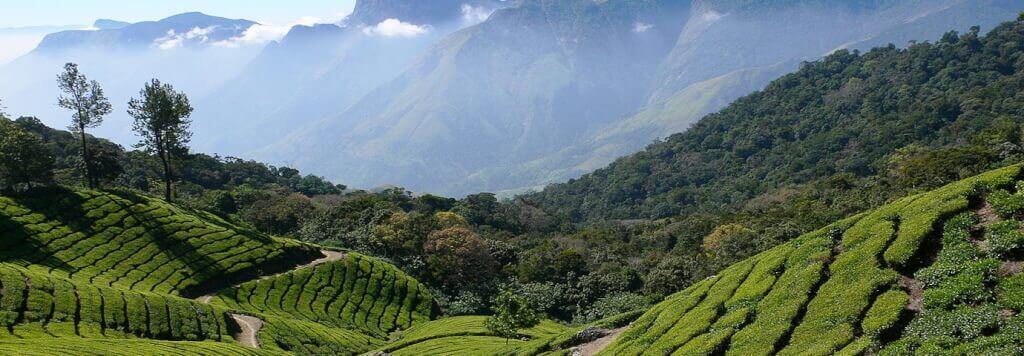
Tea plantations and Shola forests beside each other! – A beautiful irony
After all the above known and may unknown threats, there still exist patches of shola forests here and there. They thrive in silence in the protection of national forests and wildlife sanctuaries.
Why are they important?
Why am I shouting so far that they are important? They are important because,
- The shola forests have high water retention capacity than any other soil. These forests absorb the Monsoon rains and they retain them within their soil. The retained water is then slowly released in the year’s course and they form small streams. These streams join to form larger streams that form rivers that feed the entire civilizations in the plains down.
- They are the source of water in rivers live Cauvery, Thamirabarani, Vaigai. These rivers are perennial and they never go dry like the Ganges in North India. River Ganges is perennial because it is fed by a melting glacier all year-round. There is no ice in the Western Ghats and yet these rivers manage to supply water all round the year. The reason behind this is the presence of Shola forests.
- They are the reason for moderate climates for several cities along their foothills. Example – Coimbatore, a city that is near the Western Ghats in Western Tamil Nadu. The city unlike other cities in Tamilnadu enjoys a moderate climate all year round.
- They are home to several endemic species of plants and animals. Endemic means that they can exist only in that specific region and not found in any other part of the world. Without these forests, they lose their habitat and they will eventually go extinct.
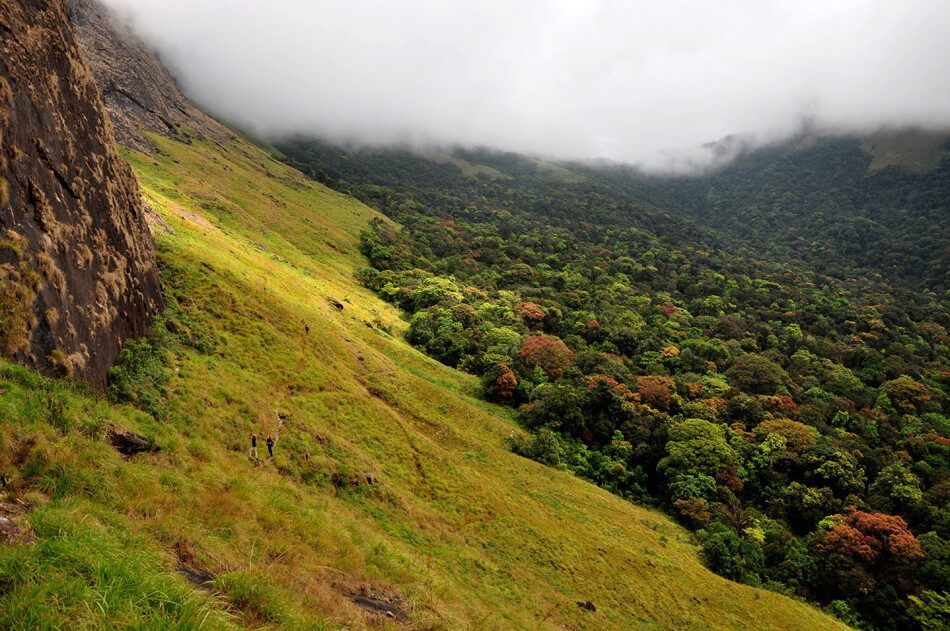
Shola forest and grassland complex in Grass Hills National Park, Valparai, Tamilnadu, India.
Unique Characters:
Sky Islands – The shola forests form unique regions called “Sky Islands” which occur only at higher elevations are usually isolated and separated from each other and the lowland terrain. The distance of separation may be from a few meters to several hundred kilometers. Each sky island may have a unique climatic condition. This leads to great endemism in plants and animals. They adapt themselves to that climatic condition and they evolve there. As a result, they cannot live outside the climatic region where they are supposed to exist! Surprising nature!
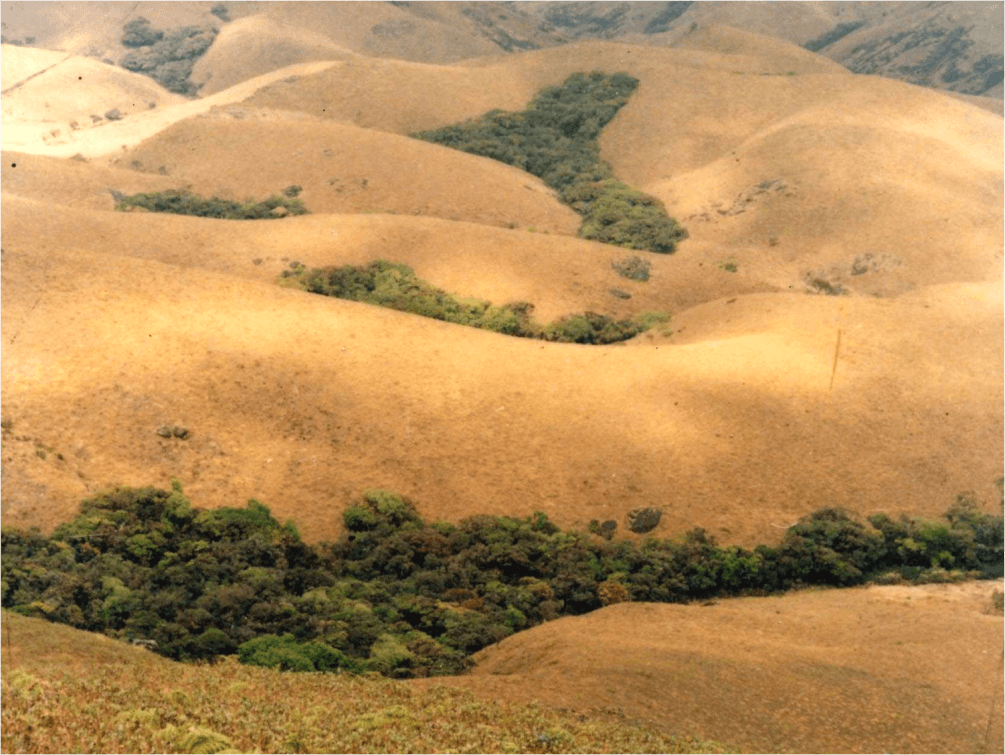
Examples of Sky Islands – Patches of forests that are separated by grasslands have unique characteristics!
Climatic climax – The shola forest and grassland complex has been described as climatic climax vegetation with forest regeneration and expansion restricted by climatic conditions such as frost or soil characteristics. The soil characteristics widely vary between the Shola forest and that of the grasslands surrounding it. The soil of the grasslands are usually poor in nutrition and water retention and hence cannot support the shola species. Grass can grow even in soils with the lowest nutritive values. While the soil of the shola forests are highly nutritive and they have high water retention capacity. The top layer of the soil mainly is made of peat and leaf debris which when removed is very difficult to form again. This adds to the vulnerability of these forests.
Conclusion:
Shola forests are some of the unique gifts that were given to human beings. But we never know the value of things unless we damage it so much that we realize we cannot live without it. This is what is happening in this case and I hope there are steps taken to conserve these forests lately. But they are not enough to repair the huge damage we have caused to them. More awareness needs to be created among the public to join hands to save the unique gift given to us. I hope the Government and people will one day understand these heavens and they will once again regain their cover over the Western Ghats.
I hope this was helpful. Let me know your ideas and thoughts in the comments!




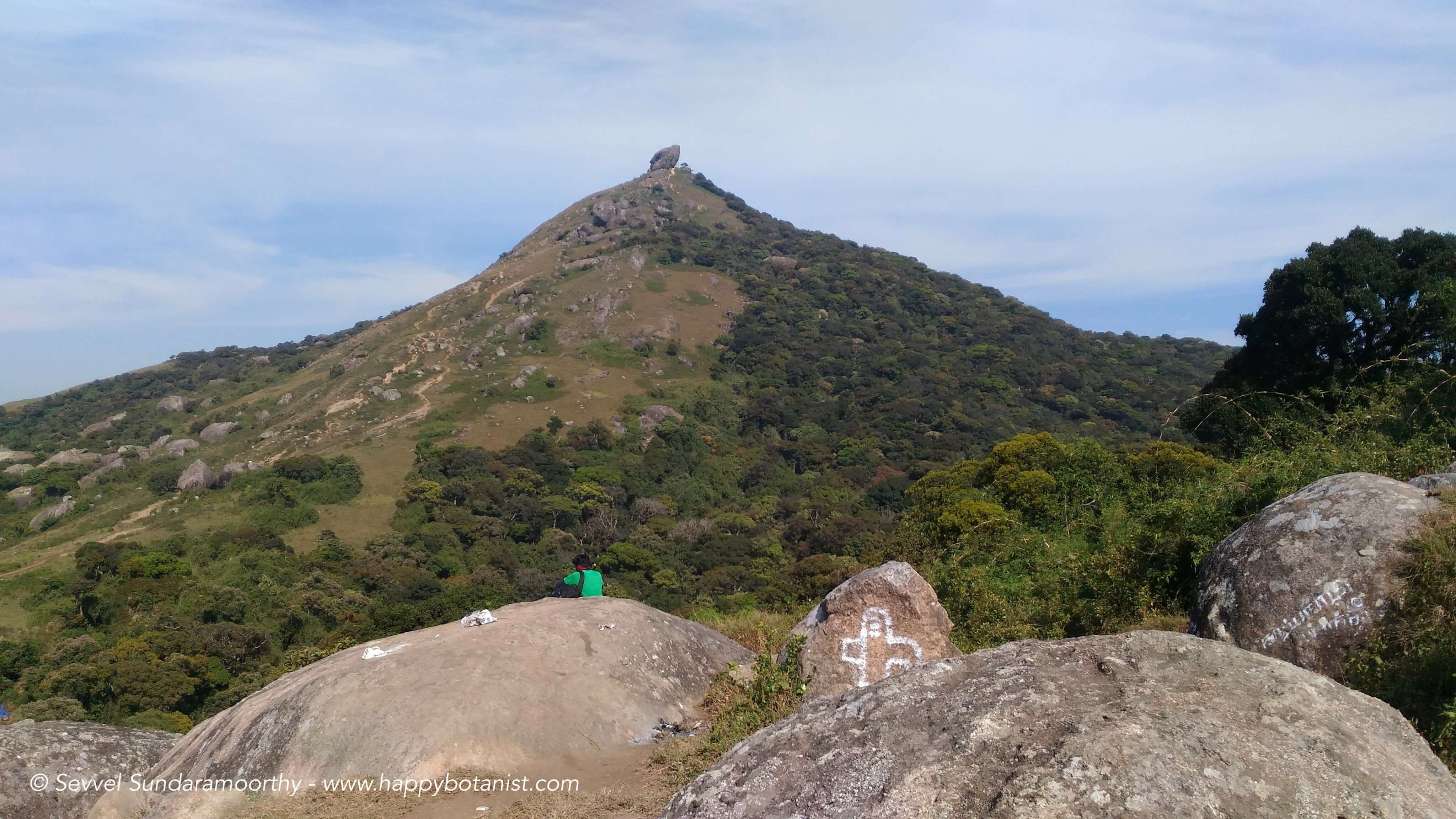

All – probably too late but we are successfully growing shola grasses, trees and shrubs on private land.(www.jadeshola.com) We procured them from a nursery in ooty , cultivated by vasanth bosco from upstream ecology. Also check out vasanths book – voice of a sentient highland
First of all, kudos to you guys. You are doing a great job. I think Nilgiris has gone beyond help now. Only large scale activities with the help of the Government and people can help revive shola grassland ecosystems. But there are very less chances for that to happen! 🙁
Extremely well explanation….. Thank you.
Very interesting article.
In case you have not sourced shola trees yet:
In Valparai, some of the tea and coffee estates maintain nurseries for the cultivation of shola tree species for reforestation purposes. Tata Coffee Estate has a nursery at Varratu Parai. They may be able to assist in the Nilgiris as well.
I understand that Korakundah estate in the Nilgiris also has such nurseries. Nature Conservation Foundation is an NGO that also may be of help in procuring shola trees for reforestation.
Thanks for all the info. I will visit Varattu parai estate for sure when I visit Valparai next time.
Great blog. I hope to visit the Nilgiri Hills next year. My daughter is named Shola after a visit there in 2006-07, and I will get her to read your page. Great information and passion! Vanessa, Western Australia
Hi
I live in Coonoor. I’ve been trying to get good quality shola saplings and not able to find the right place. Would be great if you can help me with this. I need about 100 saplings
We have shola saplings… it’s an conservation trust in kodaikanal. We can support u to get the real shola saplings.. pls contact senthil.. 9163667989
A most informative and well researched blog which is really rare. I share the exact interest and enthusiasm of the writer here. I live in the Nilgiris at Aravankadu where we have our own land.
I have been in the process of reforesting our land with native trees (sholai), where there were once extensive wattle trees which were self sown.
The information obtained from Mr. Sevvel has been most refreshing and insightful for fellow nature enthusiasts like me. I am a French lecturer by profession but a nature lover by heart.
I wish to know, like another person in this blog, which are the native trees to be planted and where to obtain them in bulk, in the Nilgiris. Till now I take trips to the native forest for saplings to transplant them in our land.
Hi Jonathan, It is always a delight to meet a fellow nature lover! I appreciate your decision to reforest your land with a Shola. It sounds exciting. However, I don’t think Shola species are not readily available in bulk like other trees. You can however try looking for Government maintained nursery in Nilgiris to see if they have any shola trees. The reason is because, most shola species cannot be cultivated owing to several reasons like climate, light and moisture requirements. Only nature can give the conditions necessary for those plants to start from seed! You can read some information about such sensitivity of the shola species in my other blog post about the Velliangiri Hills. Is there any way we can meet in person? I’m in Coimbatore. Thanks again for taking time to read my blog 🙂
very well written this article covers everything one needs to know about shola. thank you for writing and sharing. I appreciate your work.
Thanks Kiran. I’m glad that you found this useful 🙂 Please read the post about the Velliangiri Hills too! A great place 🙂
Hi. We live in Ooty and are very keen to plant Shola trees in our land. Can you suggest a website that gives information, names, pictures of these trees?
Sorry for the delayed reply. I’m really glad to hear that you have the mind to plant shola trees in your land! Great step. I’m researching about the Shola trees and will soon write a blog post on it…
Very good informational article. Its high time to protect our western ghats.
Thanks for your kind words 🙂 We’ve already lost about 90% of Shola forests and we should start palnning in growing new forests rather than to protect the existing ones!